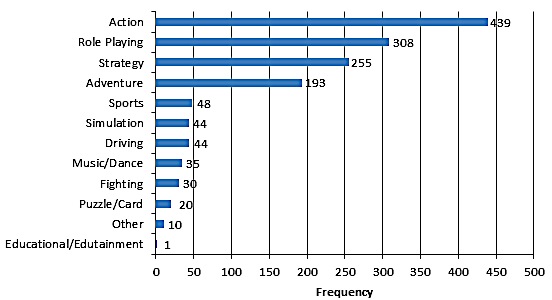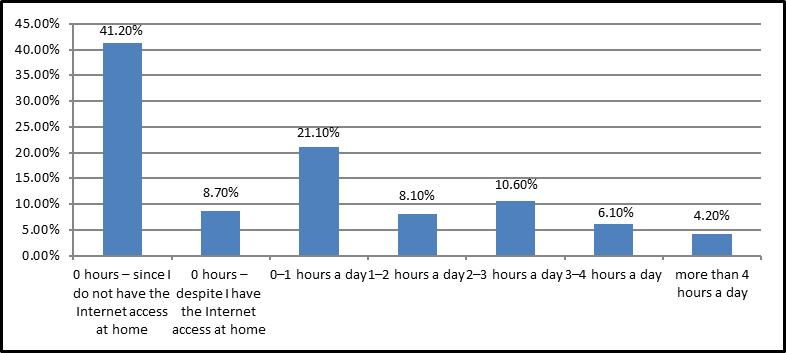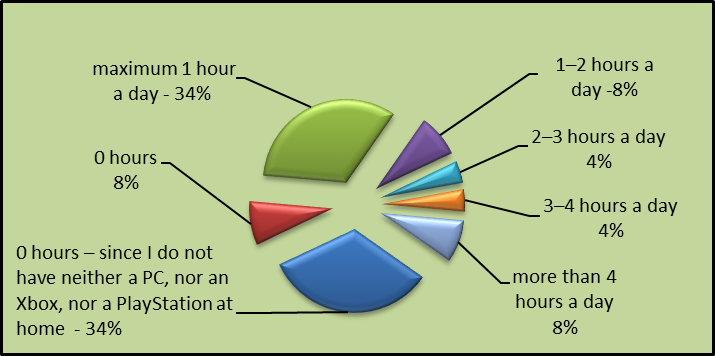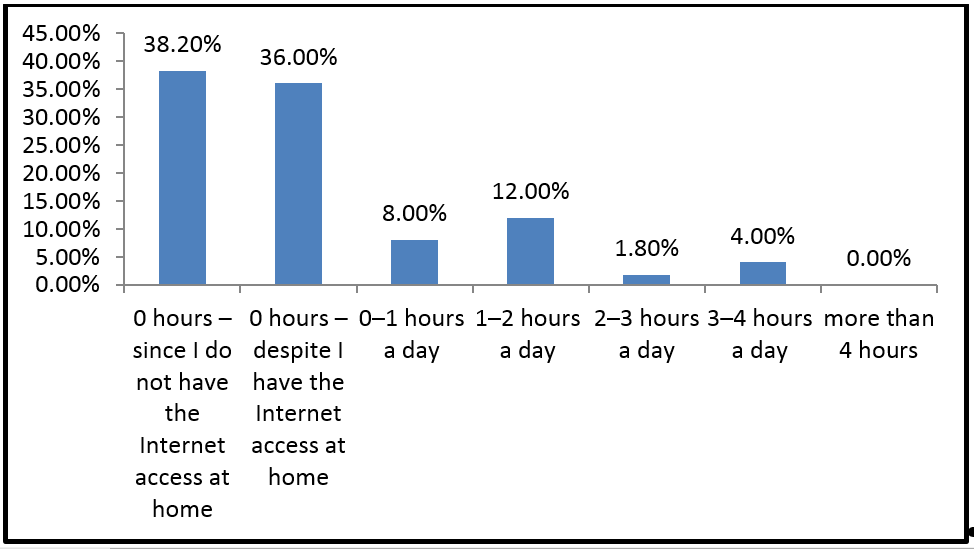Abstract
Playing computer games is popular not only among pupils but also among students and adults. Not only do educational computer games offer fun, relaxation and a good feeling of win but also a possibility to acquire new knowledge and computer skills. Games contribute to the development of the user’s algorithmic and logical thinking and they develop the user’s own winning strategy which is often the same as the optimal algorithm of solving the problem. This research paper demonstrates how students accept such indirect way of teaching and what is their relationship to computer (didactic) games. The author in her research wants to answer two main questions: Are computer games attractive and popular among students? Is it possible to increase the knowledge level of students by playing didactic computer games?
Keywords: Computer gameeducational computer gameincrease the knowledge by playing game
Introduction
The game is important not only in childhood, but also in the process of education of older children and adolescents as well as adults. This activity develops psychical functions, abilities and skills. Among children and adults, it is also an important means to relax since it is linked to the feelings of joy and excitement; therefore, the game is important also for the psychical health.
The educational dictionary defines the game as a form of activity which is different to both the work and the learning. Individuals play games for their entire life; however, the game in the pre-school age has a specific position since it is the prevailing type of activity in this period of life. In this connection, a number of aspects of games are often stated: cognitive, practicing, emotional, motoric, motivational, creative, imaginative, social, recreational, diagnostic and therapeutic aspects of the game (Průcha et al., 2008).
The application of games into the cognitive process was spread after the Second World War. Heckhausen, a German psychologist, described the game in 1964 by pointing to its five main characteristic features:
1) The game is not bound by a purpose;
2) The game fulfils the activation function;
3) There is an immediate target perspective;
4) During the game, an individual copes with the real world;
5) The game is of a quasi-reality nature (Humpolíček, 2005).
The meaning of the word
In the area of computer games, the terminology is not unanimous and it is significantly unstable. The meaning of individual terms is not identically understood and individual terms are used spontaneously while they are vaguely defined even in literature. Individual terms describe groups of games that are overlapping and they do not form disjunctive sets. That is proved also by formulations of questions and their specifications in questionnaires.
Didactic games
Didactic games are educational tools which follow didactic aims. They have a set of rules and demand continuous management and final evaluation. Didactic or often named as educational games are put into the category of innovative and modern educational tools. Didactic games are possible to be employed during lessons when explaining and fixing of knowledge as well as when adding some excitement into the lessons and motivating learners (Stoffová at al., 1995). It is possible to employ them also after lessons at school (in school clubs, during free-time activities, etc.), or at home for studying, practicing or fixing of new knowledge, doing homework or for the preparation for school lessons. Interesting interactive games with pleasant and graphic environment and with exact rules are often played spontaneously (Kožlej, 2016). They can activate pupils, keep their attention, preserve their interest for a long time and force them to a better performance. The game should correspond with the age of the player and must follow the tasks of the educational work and educational topics. In many cases, the didactic value of the game is often necessary to be discovered and used. Even many “classical” games have a didactic background and are often based on the combination of many skills which are improved in the process of playing. It is not only a question of following the rules, but also of searching of the winning strategy which is based on strategic, combinatorial, logical and algorithmic thinking. Therefore, playing a game requires not only a certain level of discipline and foresight, but it also supports the development of strategic, combinatorial, logical and algorithmic thinking of the player (
Solving problem situations, which emerge during the course of a game, also prepares the gamer for an operative solving of real problems of everyday life while it enables them to cope with difficult situations (Stoffová & Végh, 2006; Végh & Stoffová 2016a).
It is possible to classify didactic games according to their nature and content into the following categories:
Direct didactic games – in this category, the
Playful and competitive environment – didactic game itself creates only playful, joyful and competitive environment for the realization of the learning process. This category includes also e.g. various thematically-oriented quizzes which enable acquisition of new knowledge required by set standards (Végh, 2011b).
Game form – a playful form of instruction offers the processing of educational content into a game form. It motivates pupils, varies the educational process and it excites and keeps pupils’ interest – pupils are learning spontaneously without noticing that they are working. The game is employed as a realization and organization form of instruction – i.a. classical games with a purposeful educational content are employed the most. Also the game
Skills training – these games may be included in this group of simulators, e.g. flight simulators for pilots’ training, road traffic simulators for drivers’ training, practice of various surgical operations for surgeons, etc. These are actually simulators which enable not only a demonstration of a certain activity, but they also create a virtual reality in which the actor/player/subject of education may perform all of the activities that are required by the resolution of a concrete situation. This is favorable due to the possibility of analysis, evaluation and possible repetition of its process without fatal consequences which may occur during a wrong surgery or incorrect operation in reality (Végh & Stoffová 2016b). Skills training may be linked to simpler tasks as well, e.g. to the operation with? a piece of equipment in a workshop (e.g. miller, etc.). The realization of a certain experiment in a chemical, physical, biological or environmental laboratory may also be practiced with a help of a simulator even before its real performance – real experiments might be preceded with work in a virtual laboratory. The safety of laboratory work, computer and internet safety might be a topic of a didactic game and a software simulator is capable of creating various situations that have to be addressed by a user – e.g. how they should react correctly to “cyber-attacks”, attacks by social engineering, how should they protect their personal data etc.
Computer games
Computer games are very popular among the youth. PC games (or computer games or personal computer games) are video games played on a personal computer rather than on a dedicated video (game) console or arcade machine. Their defining characteristics include a lack of any centralized controlling authority, a greater degree of a user control over the video-gaming hardware and software used, and a generally greater capacity in input, processing and output (https://en.wikipedia.org/wiki/PC_game). At Wikipedia webpage devoted to computer games, they are classified into a few genres: Action, Action-adventure, Adventure, MMO (Massively Multiplayer Online Role-Playing Game), Role-playing game, Simulation, Strategy, Vehicle simulation, Other Genres. However,

The author of this paper also strove to categorize computer games (Stoffová, 2016) while she completed the categories of computer games with additional groups of games with regard to didactical possibilities. Current tendencies in the area of computer games were described by Basler (2016) in detail.
How often and who plays computer games
Stats and surveys show that computer games are popular and the majority of computer users play them while they consider them a suitable way of relaxation, mainly of psychological strengths. A mass experiment in the field of neurobiology discovered the following results:
Today’s gamer is 34 years old (on average) and has played computer games for 12 years, often for 18 hours a day. According to analytical calculations, approximately 11 million of registered users of MMORPG
Thanks to hardware and software possibilities of the PC and also of a high level of computer graphics, computer games caused (in 1990s) a collapse of console video game industry. In 1983, the consumer interest in console video games dropped to historical lows while the interest in computer games was constantly growing.

It is almost unbelievable how much time young people spend playing computer games. Even results of our research show that playing computer games is the most frequent activity of not only pupils, but also of students (Chráska & Chrásková, 2007, 2010). The age of computer users (and mainly computer games) is decreasing – children start to use computers in their early childhood (see illustrative pictures in Fig.
However, computer games are focused not only on the development of knowledge, useful attributes and positive abilities of a player. Many computer games are harmful and they support aggressiveness, violence, desire to do harm, to kill, they may decrease one’s interest in the family and the reclusiveness of gamers who withdraw into their virtual world. This often leads to the so-called gambling addiction (Chráska, 2016).
Didactic computer games
It is possible to classify didactic computer games into various categories from different points of view. The most important classification is based on the abilities they develop. According to this criterion, it is possible to classify didactic computer games into four groups:
games enriching knowledge, fixing, broadening and improving knowledge acquired during the lessons (i.a. crosswords, quizzes, etc.);
games developing perception, memory, ingeniousness, senses (i.a. rebuses, teasers, riddles, mazes, etc.);
cognitional games (games meant for concrete facts from particular area, e.g. games of technical nature; historic, literary, geographical games, etc.);
creative games (e.g. for communication development; topic, theme, constructive, interactive graphic or iconic programming etc.) –creation of educational games in the interactive environment – the so-called micro-worlds.
From the point of view of educational process where computer games are applied, it is possible to classify didactic computer games into the following groups according to their purpose:
motivation;
to acquire new knowledge and skills;
to fix knowledge and practise specific skills.
Despite large numbers of existing computer applications, the didactic potential of computer games or computer version of
Research and its results
To obtain the answers for the research question: “
Slovak respondents were pupils of a village basic school based in Nitra region. It is a small school in the country which is attended by 110 pupils from the first to its ninth grade. The school has a teaching staff which consists of 10 teachers. Pupils of all grades participated in the research; however, only one class participated in each grade. The number of pupils varied from 10 to 14 in a class (with an average of 11.67 pupils/class). Data collection was performed in a school year 2015/2016 when the school was attended by 107 pupils altogether. It is also necessary to mention that this school is attended by a large number of pupils from a socially disadvantaged environment, mainly Romani people; the percentage of those people reaches 70 per cent. In the present day, there are 16 PCs available for pupils, 3 of them are notebooks. The school got 13 PCs from various projects and 3 PCs were purchased for their own resources in 2010. All PCs are connected to the Internet. Additionally, there are 5 interactive boards with a required technical equipment and software; therefore, there is one board per 22 pupils. The readiness of teachers to use ICT is far below the Slovak average (in the framework of the international project The International Computer and Information Literacy Study – ICILS 2013 – which took place in years 2012 and 2013 and was participated by the Slovak Republic, it was found out that 98 per cent of Slovak pupils have Internet access, 97 per cent directly at home, and at least 99 per cent of pupils attend a school in which the ICT sources are available). According to the results of the project, the information and digital literacy of Slovak pupils is unbelievably high and the readiness of teachers to use the digital interactive technologies is far higher than average.

Due to the stated facts, it is possible to speak about this basic school as a specific case which does not correspond with average figures stated in report ICILS 2013 that characterize the Slovak-wide state (rephrase). In the questionnaire there participated all pupils of the school, i.e. 107 pupils. The questionnaire was composed of 14 items and we evaluated only some of them. Based on the responses to the question
The pupils’ responses to the question
The pie chart (see Graph

Responses were as follows: 0 hours – since I have neither a PC, nor an Xbox, nor a PlayStation at home – 34 per cent of pupils; 0 hours – despite the fact that I have access to computer games – 8 per cent of pupils; maximum 1 hour a day – 34 per cent of pupils; 1–2 hours a day – 8 per cent of pupils; 2–3 hours a day – 4 per cent of pupils; 3–4 hours a day – 4 per cent of pupils; more than 4 hours a day – 8 per cent of pupils.
The questionnaire shows that numerous pupils spend a large part of their free time playing games or entertaining at the Internet while this time could be used more effectively (Patay, 2016).

The questionnaire shows that numerous pupils spend a large part of their free time playing games or entertaining at the Internet while this time could be used more effectively.
The question
The pupils’ responses show that even if the pupils have a PC or the Internet access at home, only a small number of them actually use it for their education. Only just under 26 per cent of all addressed pupils use ICT to educate themselves at home, while only 5.8 per cent of them use ICT for this purpose more than 2 hours a day (Patay, 2016).
The stated numbers are alarming since basic school pupils who have the access to the Internet and digital technologies also at home prefer computer games to education.
The second research, whose results we want to present, was realized in the Czech Republic during the school year 2015/16. The research was focused on the discovery of the computer games addiction, its degree and its harmful consequences. 525 pupils of the third grade of the general upper secondary school of the Olomouc region participated in the questionnaire completion: 72 pupils attend two of general upper secondary schools directly in Olomouc while the others attend general upper secondary schools in Olomouc neighbourhood (Prostějov, Moravská Třebová, Šumperk, Konice, Rýmařov, Kroměříž, Žamberk and Litovel). The general upper secondary schools are attended by local pupils and pupils from surrounding towns and villages. The questionnaire was composed of 34 items; the following ones are important for our needs:
Do you play computer games?
Do you play on-line games?
Do you play games on Facebook?
I play computer games:
on computer
on video game console (PlayStation, Xbox)
on mobile phone
on tablet
on other devices (write down which)
For the question
The first question (
Students play games mostly on a mobile phone – this option was selected by 376 respondents (i.e. 71.62 per cent of all respondents and 87.85 per cent of all who claimed that they play computer games – almost 9 out of 10 players). 100 respondents use tablet for playing computer games (i.e. 19.05 per cent of all respondents) while the video game console is used the least – only 26 students selected this option from the presented ones (i.e. 4.95 per cent of all respondents). During the evaluation, we did not take into account the measure (i.e. the proportional division) of selected device’s usage – the respondents could select up to three devices which they use to play computer games while they also add the time share (rephrase) of playing.
The high percentage of usage of mobile devices may be explained by the possibility of employment of these devices to fill the time (while waiting for the train?, while en route, or while waiting to be served etc.) and by the availability of these devices. Another reason might be the improving intelligence of these devices, its functions and performance.
In the Czech Republic, the data collection (via the questionnaire) was carried out by a student of Faculty of Education of Palacký University Olomouc as a part of his student scientific activity. The data processing from the filled-in questionnaires and results achieved were presented at scientific conferences (Basler, 2016).
Computer and mobile didactic games
The author of this article is for a long time focused not only on the use of the popularity of computer games, but also on game forms of instruction and creation of educational software applications and didactic games. Her research is also focused on the didactics of efficient employment of these applications and the verification of their efficacy in the instruction. The results of her research have not proved a significant improvement of study results and deeper knowledge of students who were taught or had access to these applications – i.e. were taught via game form. However, it emerges from the respondents’ responses that this form of knowledge acquisition is a lesser burden for students since they are acquiring knowledge spontaneously without realizing that they are learning. In the same time, the interactivity and active participation of the user in the process of solving of a game situation (or solving of a task) supports the development of creativity and cognitive abilities of the player and it often purposefully develops abilities that are necessary to solve specific problems.
Research in this field was realized mainly among future teachers of IT in subjects related to programming, IT didactics and educational software development. The latest research was focused on discovering the opinions of future IT teachers and IT students on didactic applications which were created at departments where the author works (or worked in the past). The results were described in a number of her publications (Stoffová, 2004; Stoffová, 2008) in detail. The main results of the research, the author’s experience and her recommendations may be summarized in the following conclusions.
Conclusions and recommendations
The research results show that didactic games help students to develop their knowledge and skills. They are also able to reduce the size and make the way of solution of a real problem more effectively if it is possible to use the same or similar algorithm as in solving computer game situation. Students may easier understand the importance of the effectiveness in algorithms which express the steps of resolution process of several problems.
Students’ knowledge is deeper and more permanent when they acquire it based on their own experience while employing the principles of a constructivist theory of learning.
The educational efficacy of a didactic game improves when it is accompanied by an analysis and assessment of the player’s progress, when players’ errors and wrong steps are revealed, and when an optimal solution is shown.
Didactic computer games are motivational, they excite the attention of pupils and students and they keep it for a longer time than the teacher would be able to keep it in a common didactic situation.
Didactic computer games are played by pupils and students voluntarily and spontaneously while they are motivated and driven by their curiosity, desire for a win (for a good performance, a victory). They enable them to be “better” – to work their way up to be better.
Additionally, the pupils’ concentration on the achievement of a goal (getting a prize) is more intensive and it stays for a longer time than in a common didactic situation.
The game offers an inquiry environment, development of fantasy and creativity, and creation of winning strategies and tactics.
Educational experiments described above also prove that interactive animations and didactic games have their place in the educational process. They may be used as effective didactic tools to support the learning process.
Due to the fact that students use mostly smartphones to play games, we recommend the implementation of a mobile version for all didactic computer games in order to employ them also in a shorter free time, when “on the road”, or to use it to fill the “gaps” between major activities.
Acknowledgements
This work was supported by the grant IGA_PdF_2016_028 “Identification of risks of social networks and computer games for children depending on their preferred use of information and communication technologies”
Translator: Mgr. Jan Gregar
Language reviewer: PhDr. Zuzana Tabačková, PhD.
References
- Basler J. (2016). Počítačové hry, jejich dělení, současné tendence vývoje a základní výzkumná šetření z oblati počítačových her. In: Trends in Education Information Technologies and Technical Education. Ročník 9, 2016/1 (in press)
- Dostál, J. (2009). Výukový software a počítačové hry – nástroje moderního vzdělávání. Časopis pro technickou a informační výchovu. 1 2009, Zv. 1,
- Humpolíček, P. (2005). Diagnostika a terapie hrou – historie a současnost. Psychologie Dnes. 2005.
- Chráska, M. jun. (2016). Žáci gymnázia a míra jejich závislosti na počítačových hrách. Trendy ve vzdělávání, 9(1), 110-114.
- Chráska, M. & Chrásková, M. (2007). Postoje žáků různých typů středních škol k osobnímu počítači. Technika-Informatyka-Edukacja (suplement). Rzeszów: Uniwersytet Rzeszowski, 17-27.
- Chráska, M. & Chrásková, M. (2010). Postoje vysokoškolských studentů k osobnímu počítači v závislosti na vybraném studijním programu. Trendy ve vzdělávání. Olomouc: ALTYN, 379-381.
- Kožlej, J. (2016). Didaktické počítačové hry. (Student scientific work) – Trnavská Univerzita v Trnave, Pedagogická fakulta; Katedra matematiky a informatiky. - Supervisor: Prof. Ing. Veronika Stoffová, CSc., 2016. 36 s.
- Patay, F. (2016). Informačné a komunikačné technológie na základnej škole [PaedDr. theses]. –J. Selye University, Faculty of Education, Department of mathematics and informatics; - Supervisor: Prof. Ing. Veronika Stoffová, CSc., 2016. 88 s.
- Phan, H. M. (2016) Video Gaming Trends: Violent, Action/Adventure Games are Most Popular. Software Usability Research Laboratory [online]. 2011. [cit. 2016-04-09]. Available: http://usabilitynews.org/video-gaming-trends-violent-actionadventure-games-are-most-popular/
- Polsinelli, P.(2013). Why is Unity so popular for videogame development. [Online] 2013. http://designagame.eu/2013/12/unity-popular-videogame-development/. (cit. 2016-04-09)
- Průcha, J. & Walterová, E. & Mareš, J. (2008). Pedagogický slovník. Praha : Portál, 2008. s. 322. ISBN 978-80-7367-416-8.
- Slocum J. & Sonneveld, D. (2006). The 15 Puzzle. 2006. s. 144. ISBN 1-890980-15-3.
- Stoffová V.: Počítačové hry a ich klasifikácia In: Trends in Education Information Technologies and Technical
- Stoffová, V. (1994) Didactic computer games. In: Information technology in education in Slovakia (NAITFE Conference). Bratislava – London : Basford Hall College – Institute for Information and Prognoses on Education, 1994, s. 16-24.
- Uhlířová, J. (1999). Hrové činnosti předškolního věku v pojetí J. A. Komenského. Praha : Pedagogická fakulta UK, 1999.
- Végh L. (2011a) From bubblesort to quicksort with playing a game (Hravou formou od bublinkového triedenia po rýchle triedenie), in: XXIX. International Colloquium on the Management of Educational Process, (J. Neubauer and E. Hájková, eds.), University of Defence, Brno, CZ, 2011, 539–549.
- Végh L. (2011b). Animations in Teaching Algorithms and Programming (Animácie vo vyučovaní algoritmov a programovania), in: Nové technologie ve vzděláváníı, (J. Dostál, ed.), Palacký University, Olomouc, CZ, 2011, 47–51.
- Stoffa, V. (2004) Modelling and simulation as a recognising method in the education, Educational Media International 41, no. 1 (2004), 51–58.
- Stoffa V. (2008) Az animáció szerepe az elektronikus tankönyvekben, Információs társadalom VIII, no. 3 (2008), 113–125.
- Stoffová V. & Skalka, J. & Morvai, M. (1995): Didaktické počítačové hry. Informatika v škole, 1995, č. 12, s. 19-24.
- Stoffová V. & Végh L.(2006): Počítačové hry a projektové vyučovanie programovania. (Computer games and project oriented teaching of programming). XXIV International Coloquium on the Acquisition Process Management : Proceeding of abstracts and electronic version of reviewed contributions on CD-ROM. Editori Eva Hájková a Rita Vémolová. Brno : University of Defence, Faculty of Economics and Management, 2006, s. 51 (abstract), CD-ROM. ISBN 80-7231-139-5
- Végh L. & Stoffová V. (2016) Algorithm Animations for Teaching and Learning Programming: Interactive Card Animations for Understanding of the Main Ideas of Basic Sorting Algorithms (in press).
- Végh L. & Stoffová V. (2016): An interactive animation for learning sorting algorithms: How students reduced the number of comparisons in a sorting algorithm by playing a didactic game. Teaching Mathematics and Computer Science. Proof-sheets (2016), 1–18
- Internet sources:
- https://en.wikipedia.org/wiki/PC_game (cit. 2016-04-09)
- http://www.tyden.cz/rubriky/zdravi/stale-vice-vedcu-tvrdi-pocitacove-hry-nemuseji-byt-nutne-skodlive_228080.html (cit. 2016-04-09)
- https://www.google.sk/search?q=computer+games&biw=1366&bih=635&tbm=isch&tbo=u&source=univ&sa=X&ved=0ahUKEwjI5bua8o7OAhWE7BQKHVFzBnEQsAQIngE&dpr=1#imgrc=BSY58GCBwamc_M%3A (cit. 2016-04-09)
Copyright information

This work is licensed under a Creative Commons Attribution-NonCommercial-NoDerivatives 4.0 International License.
About this article
Publication Date
18 December 2019
Article Doi
eBook ISBN
978-1-80296-015-0
Publisher
Future Academy
Volume
16
Print ISBN (optional)
-
Edition Number
1st Edition
Pages
1-919
Subjects
Education, educational psychology, counselling psychology
Cite this article as:
Stoffová, V. (2019). The Importance of Didactic Computer Games in the Acquisition of New Knowledge. In Z. Bekirogullari, M. Y. Minas, & R. X. Thambusamy (Eds.), ICEEPSY 2016: Education and Educational Psychology, vol 16. European Proceedings of Social and Behavioural Sciences (pp. 676-688). Future Academy. https://doi.org/10.15405/epsbs.2016.11.70

